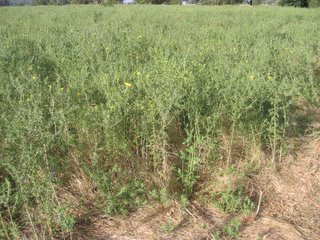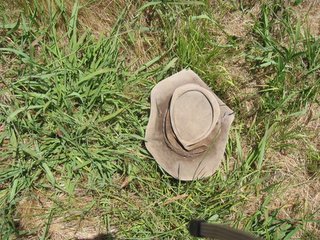
This is the finest crop of rank grass and saffron thistle we have ever grown. The sheep cannot eat it; it is virtually impassable for them; and any succulent grasses beneath it are unavailable to them.

This is what the ground looks like when freshly mulched.

And this is the result two-and-a-half weeks later. The best spot…

The worst spot…

The results were widespread, tested in 4 paddocks. Happy days. Mulching is a temporary solution for us while we work on our fencing.
...............
There are four ways that I know to get pasture grass to grow. 1. The traditional way: sowing exotic species like white clover, and fertilising the soil with artificial fertilisers like Superphosphate (an expensive solution that leaves the ground bare when the clover has had its season and has to be repeated a couple of seasons later, plus the exotics can’t be relied upon to feed livestock all year round.) 2. Pasture cropping, pioneered by Col Seis, a man we admire very much. By direct drilling seed like oats into a pasture you get a crop to harvest or graze, plus the native perennial pasture species seem to love it. (We were one of the first farms to use the process commercially. More about our experience with pasture cropping in another blog.) 3. Animal impact. Allan Savory’s Holistic Resource Management system uses the tilling effect of animals’ hooves and the fertilising effect of animal dung, especially when large numbers are concentrated in small areas, then moved off the plot for up to a year to let it recover. Pastures respond with enthusiasm. (David Marsh of ‘Allendale’ at Booroowa has a textbook case of this theory at work. Again, I’ll bring you pics of David’s place in a later blog. I can’t wait to visit him. He’s a genius and a gentleman.) 4. Mulching, as a gardener does. Mulching puts litter on the ground which encourages the worms and bugs that make soil. It also encourages pasture grasses to rebound. We have two methods of mulching: spreading hay on bare soil and shredding rank and dead grasses and thistles using a special attachment for the tractor.




No comments:
Post a Comment